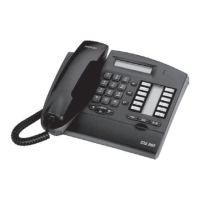SECURITY E-SERVER : INTERNET APPLICATIONS
Ed. 042/10 Réf. 3EH 21000 BSAA
- Certain Internet access configuration options:
• OmniPCX Office used as mail server (or not);
• Explicit authorization of an application or protocol (cf. <Protocol Control>);
- Authorization or refusal of Internet access on the basis of the user's "position" in the local
network (cf. <Services Access>).
NAT (Network Address Translation)
Definition:
- NAT is a mechanism devised to palliate the shortage of web addresses. It enables a group of com-
puters in a local network to access the Internet using a single IP address, in this case that of Om-
niPCX Office, which makes it appear as the only system using the Internet connection.
Remarque : OmniPCX Office only has one official IP address at any given moment – the one provi-
ded by the currently active ISP. The correlation of addresses in the NAT process is the-
refore always of the type: n local addresses to 1 public address.
How it works:
- Computer X is instructed that OmniPCX Office is its default gateway.
- When a packet arrives in OmniPCX Office from X, it is assigned a new port number, and the Om-
niPCX Office IP address is declared in the packet header, without overwriting the original header.
The modified packet is then sent to the Internet via the PPP interface.
- When a packet arrives in OmniPCX Office from the Internet, if the port number is one of the num-
bers assigned in the preceding stage, then the header is again modified to restore the original port
numbers and IP addresses, and the packet is passed on to machine X.
Advantages:
- flexibility in the private address plan of the LAN;
- the shared use of a single public IP address for any number of private addresses in the LAN;
- tighter security by using only one IP address that can be identified on the Internet.
Restrictions:
These are of two kinds:
- An OmniPCX Office user (see User Management) is an Internet service client.
In this case certain protocols are incompatible with NAT, either because they make use of the port
numbers or because they encode IP addresses. The table below lists applications or protocols and
their compatibility with NAT.

